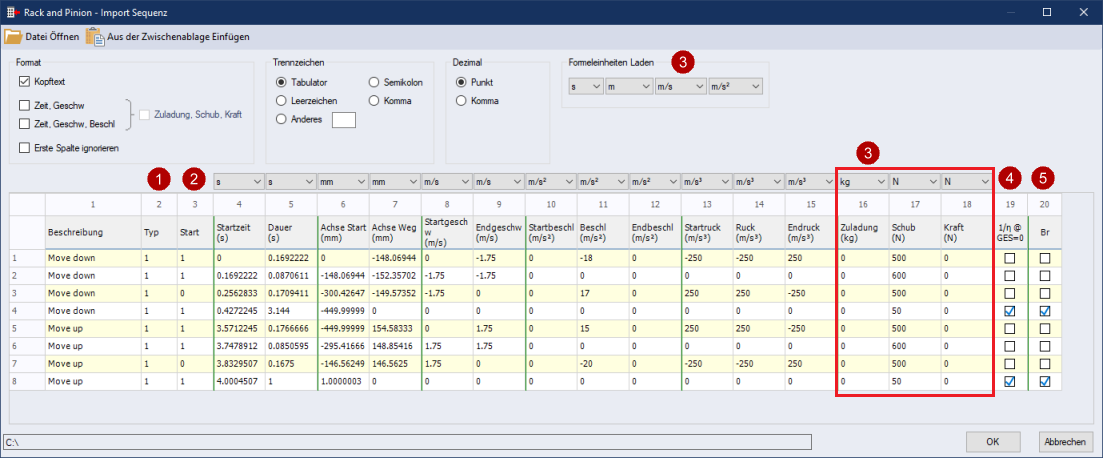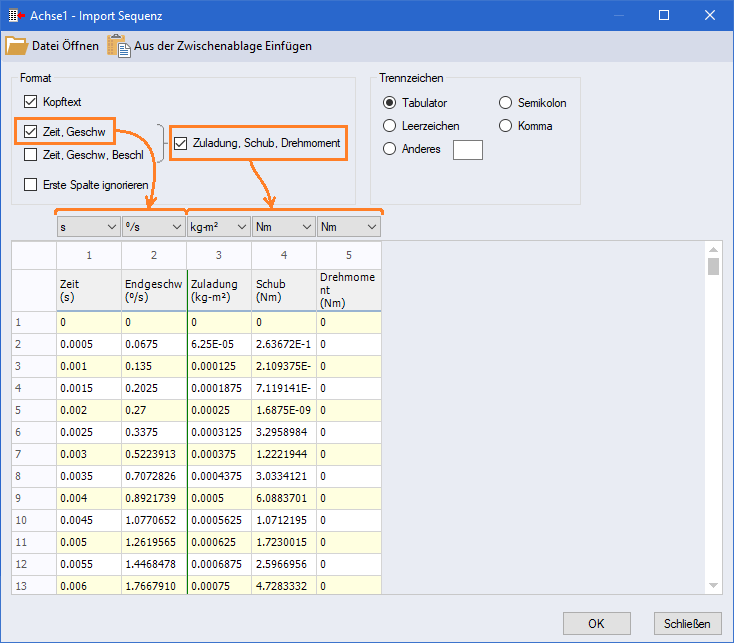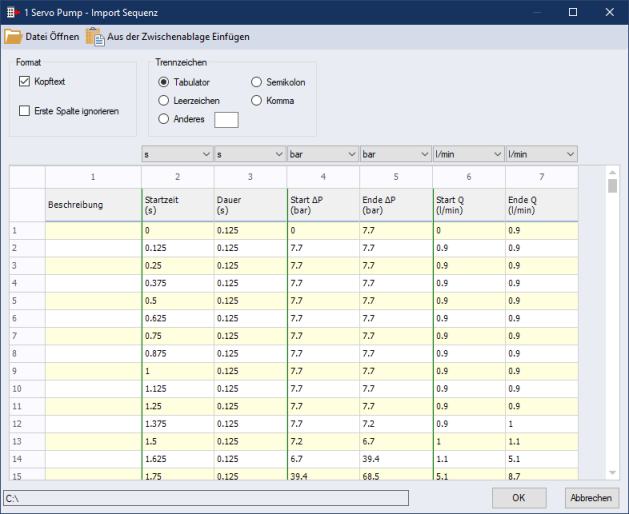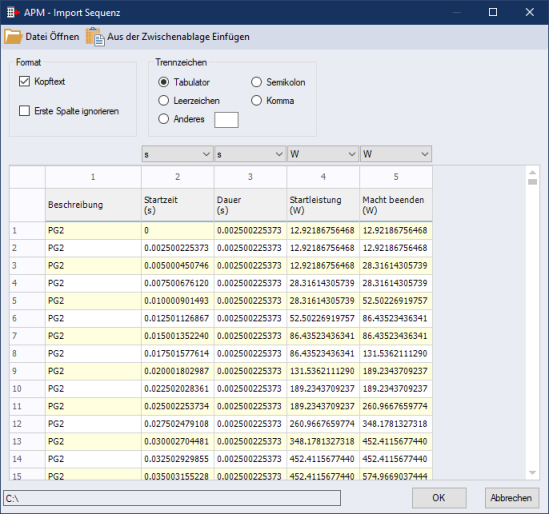Sequenz Importieren |
Importieren Sie eine vollständige Achsenabfolge aus der Zwischenablage, Excel oder einem Textdokument.
Bewegung, Pump Druck und Volumenstrom und Leistung gegen Zeit Sequenz sequenzen werden unterstützt.
Um eine Abfolge zu importieren, wählen Sie im Menü "Abfolge > Import", wie angezeigt.

 Bewegungssequenz
Bewegungssequenz
Es gibt zwei Ansätze, um den Import einer Sequenz. Der Sequenz Methode wie unten mit den 18 oder 19 (mit Brake On/Off-Spalte) Spalten angezeigt und hinweise unter oder die generischen Spalten Zeit und Weg oder Zeit und Geschwindigkeit.
 Sequenz
Sequenz
Öffnen Sie zunächst die Datei, die importiert werden soll, oder fügen Sie diese aus der Zwischenablage ein. Tragen Sie dann Angaben zu Datenformatkriterien wie z.B. Begrenzungszeichen ein und geben Sie an, ob die erste Zeile Header-Daten enthält und somit ignoriert werden soll. Die Datentabelle wird nun automatisch aktualisiert.
Wenn das Datenformat nicht kompatibel ist, werden die Zellen mit "-999999" oder "!Formel" gefüllt, um den Fehler zu lokalisieren.

|
|
Die Spalte unter Typ beschreibt den Profiltyp. Die Profiltypenwerte sind in der untenstehenden Tabelle aufgeführt:
|
||||||||||||||||||||||||||||||||||||||||||||||||||||||||
|
|
Die Spalte unter Anfang beschreibt, ob der Abschnitt ein Anfangs- oder Endabschnitt ist. Sie bezieht sich auf asymmetrische Profiltypen, wie z.B. Unterabschnitt Linear, modifizierter Sinus und modifizierter
|
||||||||||||||||||||||||||||||||||||||||||||||||||||||||
|
|
Das Importieren der Lastformel wird für jede der Lastspalten [Nutzlast, Schub, Drehmoment / Kraft, Fr, Fa, rUL, mUL] unterstützt. Wenn ein Wert in einer Load-Spalte keine Zahl ist, wird für diesen Wert eine Formel angenommen. Formeleinheiten laden werden in die "Basis" -Einheiten gezwungen und gelten für alle importierten Formeln. Daher müssen alle importierten Formelvariablen die Basiseinheiten für Rotary [s, °, °/s, °/s2] und Linear [s, m, m/s, m/s2] verwenden. |
||||||||||||||||||||||||||||||||||||||||||||||||||||||||
|
|
Die Spalte 1/n @ GES=0 (Motorisch im Stillstand) gibt an, ob der Mechanismus „motorisch“ ist, was bedeutet, dass er den Schub/das Drehmoment/die Kraft anwendet und daher der Wirkungsgrad [1/n] ist. Wenn nicht markiert, ist die Mechanismuseffizienz [n].
|
||||||||||||||||||||||||||||||||||||||||||||||||||||||||
|
|
Die Spalte Bremse gibt an, ob die Motorbremse während eines Verweilzeitsegments EIN oder AUS ist. Diese Spalte ist nur verfügbar, wenn Motorbremsensteuerung = Bremse Ein / Aus definiert in Sequenz ist.
|
||||||||||||||||||||||||||||||||||||||||||||||||||||||||
| Anmerkungen | |
|---|---|
| 1. | The imported data columns must match the sequence columns. |
| 2. | If the sequence uses the Motor Brake On/Off defined in the sequence, then the imported data must inlcude Motor Brake On/Off column. |
| 3. | When a Rotary Mechanism and if the sequence uses some or all of the Shaft Loads, Fr, Fa, rUL & mUL columns, then the imported data must inlcude these columns as well. |
 Zeit und Weg / Zeit und
Geschwindigkeit
Zeit und Weg / Zeit und
Geschwindigkeit
Zeit und Weg oder Zeit und Geschwindigkeit sind generische Methoden, um praktisch jede dynamische Bewegungsprofil als Sequenz importieren, wie unten gezeigt. Mit diesen Methoden gibt es auch die Option Zuladung, Schub, Drehmoment, die drei weitere Spalten enthält, um benutzerdefinierte dynamische Last-, Schub- und Drehmomentprofile aufzunehmen.

| Anmerkungen | |
|---|---|
| 1. | It is very important to maintain decimal accuracy for each Time, Velocity and Accel value. This means keeping many decimals, perhaps as many as 20 decimal places. The reason is small variations in the Time, Velocity and Accel values can lead to "spikes" in the resulting motion profile and torque calculations. |
| 2. | Using Time, Velocity and Accel allows the program to calculate the Jerk profile and the resulting Jerk profile is useable. When only Time and Velocity are provided, then the Accel is calculated, and the resulting Jerk profile cannot be calculated reliably, so the Jerk profile is set to 0 |
 Druck und Volumenstrom
Druck und Volumenstrom
Time, Pressure and Flow is the method used to import any dynamic load sequence for a Servo Pump.

| Notes | |
|---|---|
| 1. | The imported data columns must match the sequence columns. |
| 2. | If the sequence uses a Dual Pump configuration, then the imported data must inlcude Pump A & B columns to specify when each pump is On/Off. |
| 3. | If the sequence uses a Variable Displacement, then the imported data must include the Start/End Displacement columns. |
 Leistung gegen Zeit
Leistung gegen Zeit
Time and Power is the method used to import any dynamic power sequence for the Auxliary Power Module (APM).

 Schnellimportsequenz
Schnellimportsequenz
When importing directly from a file, all import settings are saved, and the Import Sequence button appears at the top right of the Sequence form. Hover over the button and it will show the details of the source file.

If the source file changes, the Import Sequence button will turn yellow to bring attention to the user. Click on it to open the Import Sequence form with all settings as before and the new source file data. Then click OK to accept the new data. Ie. The Sequence is re-imported in 2 clicks.
